Fall 2022
Drought Tolerant Native Groundcovers
by Kate Verhoef and Laurinda Ochoa
Fall is the best time to plant in California’s dry-summer, wet-winter Mediterranean climate. Many people want to replace, in whole or in part, their water-hungry lawns that require constant mowing and fertilizing. There are many interesting drought-tolerant groundcovers that can replace our common turf grass.
Commonly-available groundcovers range from low-spreading plants that quickly fill in to upright, sprawling plants that colonize and feed hungry hummingbirds and pollinators. This article includes just a few of California’s many drought-tolerant groundcover plants.
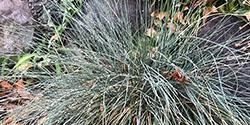
Fescue, courtesy L.Ochoa
Fescues are common native grasses in the Festuca family. In California there are 19 forms of Festuca that are adapted to different growing conditions and have slightly different growth patterns. All fescues are clumping grasses, and do not spread by stolons. Fescues are heat and drought tolerant, and don't require regular mowing or fertilization. There are several commercial Fescue mixes available to create natural appearing meadows to replace traditional lawn turf grasses.
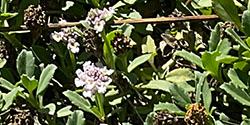
Lippia, courtesy L.Ochoa
Common Lippia, or Phyla nodiflora (also known as Lippia repens), is a low-growing broadleaf ornamental plant of 1–6 inches in height with small green leaves and light pink to white small flowers that are attractive to bees, butterflies, and other pollinators. For households with bee sting allergies, this plant is not recommended. Once established, it grows in full sun with little to no water. It also grows in low shade but may not produce as many flowers. It thrives throughout Contra Costa County and is commonly used as a lawn substitute because it forms a dense spreading green mat people and pets can walk upon.
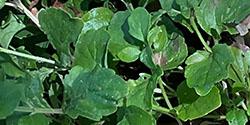
Yerba Buena, courtesy L.Ochoa
Yerba Buena, or Clinopodium douglasii, is a creeping perennial herb that grows naturally along the California coast. The Spaniards named their original trading post Yerba Buena for this native plant which covered the area they later named San Francisco. Yerba Buena has a delicate appearance, with tiny green leaves on slender stems that creep along the ground and over rocks and leaf litter. Once established, Yerba Buena grows easily near the coast with light watering and moisture from fog. In inland areas, it prefers dry shade and is less drought tolerant as it appreciates a sprinkling of water to stay lush in the hot summer months. Like Lippia, Yerba Buena can tolerate light foot traffic so people and pets can walk on it and enjoy its light minty fragrance.
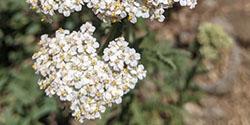
Yarrow, courtesy K.Verhoef
Yarrow, our native Achillea millefolium, makes an excellent groundcover, and can also be used as a turf substitute, as it can handle light foot traffic and mowing. This perennial herb has feathery, aromatic leaves and in spring and summer its stems, ranging from 6 inches to over 3 feet in height, produce white to pink flat-headed flowers. It makes an excellent addition to a meadow garden, as its flowers are very attractive to butterflies and bees. In West County, yarrow is completely drought resistant once established; in interior regions, it will benefit from watering once a month or so.
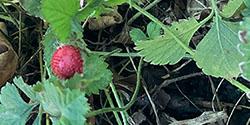
Beach Strawberry, courtesy L.Ochoa
Wild Strawberry is another perennial herb native to California that grows easily both inland and along the coast. There are two common forms of our wild strawberry. The Coastal Strawberry, or Fragaria chiloensis, grows best along the coast in sandy soils with full sun or part shade and has very low to low water requirements. The other is the Woodland Strawberry Fragaria vesca, which grows further inland and can tolerate heavier clay soils and full shade, or grow in full sun or part shade, but may need more water after being established. Both grow by sending out runners, have small white flowers and produce small edible fruits enjoyed by birds and small mammals.
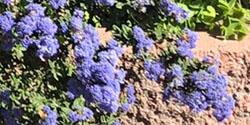
Ceanothus, courtesy L.Palmquist
Carmel Creeper Ceanothus, or Ceanothus griseus horizontalis, is a beautiful shrub that can function as a groundcover. Native to the Bay Area, it is very drought tolerant and will grow to 1–3 feet in height and spread up to 15 feet. Its trailing habit makes it a good fit for a dry slope or retaining wall. It has glossy leaves and in spring makes a beautiful show of its bee-attracting medium blue flowers. It prefers full sun but will thrive in light shade on little to no water once established. Do note, however, that it is one of the least deer-resistant of our native California Lilacs.
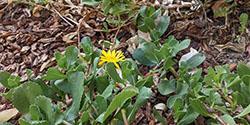
Grindelia, courtesy K.Verhoef
Spreading Gum Plant, Grindelia stricta var. platyphylla, is a good choice for a drought-tolerant West County meadow garden. It stays less than 1 foot tall, and spreads up to 10 feet. Native to coastal areas throughout the state, it is a summer and fall bloomer that is very attractive to butterflies, and looks wonderful with native buckwheat, fuchsia, and sagebrush in a habitat garden. Its bright yellow, daisy-like flowers and bright green leaves make it a cheerful choice for the summer-dry garden.
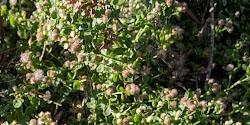
Coyote Brush, courtesy K.Verhoef
Pigeon Point Coyote Brush is a cultivar of Baccharis pilularis with a low and spreading growth habit, making it ideal for use as a groundcover. It is evergreen with bright green rounded leaves. Its cream-white flowers are not showy but are an excellent late-summer nectar source for bees and butterflies. It reaches about 18 inches in height and 8 feet in width and is well suited to banks and slopes where erosion control is desired. It is not fussy about soil, likes full sun, and does very well with very little to no water once established.
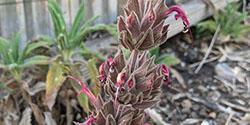
Hummingbird Sage, courtesy K.Verhoef
Hummingbird sage, or Salvia spathacea, is a vigorous ground cover that spreads by rhizomes and is truly one of the best native groundcovers for dry shade, although it will also thrive in full sun. As its name suggests, its flowers are hummingbird magnets, with bright red bracts on 1-3 foot stalks that bloom throughout the year. Hummingbird sage is remarkably easy to transplant: just dig up its lateral rhizomes and start a new colony wherever you have a lifeless patch, even under an oak tree. It’s best to do this in late fall or early winter.
Whether you’re planning to remove your water-guzzling turf grass completely, or replace a section of it with native plants, you'll find that any of these ground-covering habitat plants are excellent choices.
Useful Links:
- Article on Drought Tolerant Ground Covers from UCMG Contra Costa County Help Desk
- Article from UCMG Marin County on Groundcovers
- Article from CNPS on Native Grass Alternatives to Lawn
Article by Kate Verhoef and Laurinda Ochoa, UC Master Gardeners of Contra Costa County
Photo credits: L.Ochoa, K.Verhoef, and L.Palmquist









